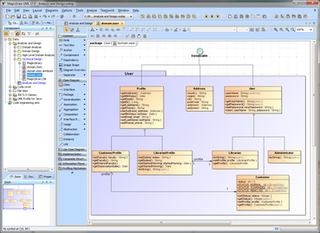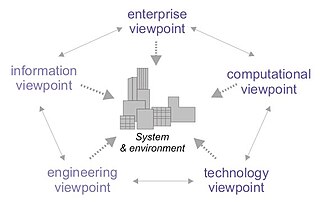
The Unified Modeling Language (UML) is a general-purpose, developmental, modeling language in the field of software engineering that is intended to provide a standard way to visualize the design of a system.
The XML Metadata Interchange (XMI) is an Object Management Group (OMG) standard for exchanging metadata information via Extensible Markup Language (XML).

The Meta-Object Facility (MOF) is an Object Management Group (OMG) standard for model-driven engineering. Its purpose is to provide a type system for entities in the CORBA architecture and a set of interfaces through which those types can be created and manipulated. The official reference page may be found at OMG's website.
Model Driven Architecture (MDA) is a software design approach for the development of software systems. It provides a set of guidelines for the structuring of specifications, which are expressed as models. Model Driven Architecture is a kind of domain engineering, and supports model-driven engineering of software systems. It was launched by the Object Management Group (OMG) in 2001.
The Object Constraint Language (OCL) is a declarative language describing rules applying to Unified Modeling Language (UML) models developed at IBM and is now part of the UML standard. Initially, OCL was merely a formal specification language extension for UML. OCL may now be used with any Meta-Object Facility (MOF) Object Management Group (OMG) meta-model, including UML. The Object Constraint Language is a precise text language that provides constraint and object query expressions on any MOF model or meta-model that cannot otherwise be expressed by diagrammatic notation. OCL is a key component of the new OMG standard recommendation for transforming models, the Queries/Views/Transformations (QVT) specification.

A metamodel or surrogate model is a model of a model, and metamodeling is the process of generating such metamodels. Thus metamodeling or meta-modeling is the analysis, construction and development of the frames, rules, constraints, models and theories applicable and useful for modeling a predefined class of problems. As its name implies, this concept applies the notions of meta- and modeling in software engineering and systems engineering. Metamodels are of many types and have diverse applications.

The Department of Defense Architecture Framework (DoDAF) is an architecture framework for the United States Department of Defense (DoD) that provides visualization infrastructure for specific stakeholders concerns through viewpoints organized by various views. These views are artifacts for visualizing, understanding, and assimilating the broad scope and complexities of an architecture description through tabular, structural, behavioral, ontological, pictorial, temporal, graphical, probabilistic, or alternative conceptual means. The current release is DoDAF 2.02.

Unicom System Architect is an enterprise architecture tool that is used by the business and technology departments of corporations and government agencies to model their business operations and the systems, applications, and databases that support them. System Architect is used to build architectures using various frameworks including TOGAF, ArchiMate, DoDAF, MODAF, NAF and standard method notations such as sysML, UML, BPMN, and relational data modeling. System Architect is developed by UNICOM Systems, a division of UNICOM Global, a United States-based company.
The British Ministry of Defence Architecture Framework (MODAF) was an architecture framework which defined a standardised way of conducting enterprise architecture, originally developed by the UK Ministry of Defence. It has since been replaced with the NATO Architecture Framework.
Model-driven engineering (MDE) is a software development methodology that focuses on creating and exploiting domain models, which are conceptual models of all the topics related to a specific problem. Hence, it highlights and aims at abstract representations of the knowledge and activities that govern a particular application domain, rather than the computing concepts.

The Systems Modeling Language (SysML) is a general-purpose modeling language for systems engineering applications. It supports the specification, analysis, design, verification and validation of a broad range of systems and systems-of-systems.

MagicDraw is a visual UML, SysML, BPMN, and UPDM modeling tool with team collaboration support. Designed for business analysts, software analysts, programmers, and QA engineers, this dynamic and versatile development tool facilitates analysis and design of object oriented (OO) systems and databases. It provides the code engineering mechanism, as well as database schema modeling, DDL generation and reverse engineering facilities.

Reference Model of Open Distributed Processing (RM-ODP) is a reference model in computer science, which provides a co-ordinating framework for the standardization of open distributed processing (ODP). It supports distribution, interworking, platform and technology independence, and portability, together with an enterprise architecture framework for the specification of ODP systems.
The Business Process Definition Metamodel (BPDM) is a standard definition of concepts used to express business process models, adopted by the OMG. Metamodels define concepts, relationships, and semantics for exchange of user models between different modeling tools. The exchange format is defined by XSD and XMI, a specification for transformation of OMG metamodels to XML. Pursuant to the OMG's policies, the metamodel is the result of an open process involving submissions by member organizations, following a Request for Proposal (RFP) issued in 2003. BPDM was adopted in initial form in July 2007, and finalized in July 2008.
Knowledge Discovery Metamodel (KDM) is a publicly available specification from the Object Management Group (OMG). KDM is a common intermediate representation for existing software systems and their operating environments, that defines common metadata required for deep semantic integration of Application Lifecycle Management tools. KDM was designed as the OMG's foundation for software modernization, IT portfolio management and software assurance. KDM uses OMG's Meta-Object Facility to define an XMI interchange format between tools that work with existing software as well as an abstract interface (API) for the next-generation assurance and modernization tools. KDM standardizes existing approaches to knowledge discovery in software engineering artifacts, also known as software mining.
AGATE is a framework for modeling computer or communication systems architecture.
Architecture-driven modernization in computing and computer science, is the name of the initiative of the Object Management Group related to building and promoting standards that can be applied to modernize legacy systems. The objective of this initiative is to provide standard representations of views of existing systems, in order to enable common modernization activities, such as code analysis and comprehension, and software transformation.
The Semantics of Business Vocabulary and Business Rules (SBVR) is an adopted standard of the Object Management Group (OMG) intended to be the basis for formal and detailed natural language declarative description of a complex entity, such as a business. SBVR is intended to formalize complex compliance rules, such as operational rules for an enterprise, security policy, standard compliance, or regulatory compliance rules. Such formal vocabularies and rules can be interpreted and used by computer systems. SBVR is an integral part of the OMG's model-driven architecture (MDA).
The Ontology Definition MetaModel (ODM) is an Object Management Group (OMG) specification to make the concepts of Model-Driven Architecture applicable to the engineering of ontologies. Hence, it links Common Logic (CL), the Web Ontology Language (OWL), and the Resource Description Framework (RDF).

Sparx Systems Enterprise Architect is a visual modeling and design tool based on the OMG UML. The platform supports: the design and construction of software systems; modeling business processes; and modeling industry based domains. It is used by businesses and organizations to not only model the architecture of their systems, but to process the implementation of these models across the full application development life-cycle.








